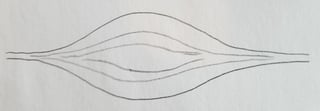Let $F$ be an orientable surface with a foliation $\cal F$ with $k$-prong singularities only, for $k\geq 3$.
Since I am looking for an invariant transverse measure on $\cal F$, assume that there is no circle leaf in $\cal F$ to which some other leaves are spiraling to and there is no infinite leaf with foliation like in the first pic.
Even then $\cal F$ may not have an invariant transverse measure because of Denjoy blowup (pictured on the right) possibility (as pointed to me by Lee Mosher).
Is it true however that there is a subsurface $F_0\subset F$ bounded by leaves of $\cal F$ with an invariant transverse measure on $\cal F\cap F_0$ such that $F-F_0$ is a union of topological disks? Can it be assumed that those disks are infinite bigons foliated as on the right? If not then perhaps some slightly weaker statement holds?


